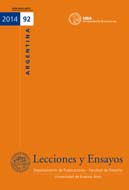"Amicus curiae" en el plano internacional
Keywords:
amicus curiæ, friends of the cour, amici, fragmentation of international law, international jurisdiction, international court of justice, international criminal court, international criminal tribunal for the former yugoslavia, international criminal tribunal for rwanda, special court for sierra leone, inter-american court of human rights, inter-american commission on human rights, european court of human rights, international centre for settlement of investment disputes, world trade organization.Abstract
Before analyzing the procedural institution of the amicus curiae throughout an array of international judicial bodies, the phenomenon known as “fragmentation of International Law” must be considered. This initial background will enable us to achieve a better understanding of the way this institution is used in the different international jurisdictions, and it will help us drawing certain distinctions within them. Subsequently, we will study the amicus curiae itself, its development and its application in general terms. Finally, we will pay particular attention to the way this institution is employed at an international level, the core of this research work.
Downloads
References
APAZA, Pamela, The interaction between the Dispute Settlement Mechanisms of the American Regional Trade Agreements and the Wto, consultado en [http://www.wti.org/res/documents/Pamelaforwebpage.pdf] el 22/11/2012.
BAQUERIZO MINUCHE, Jorge, “El Amicus Curiæ: una importante institución para la razonabilidad de las decisiones judiciales complejas”, en SALMON ALVEAR, Carlos (dir. fundador), Revista Jurídica de la Universidad Católica de Santiago de Guayaquil, nº 21, Guayaquil, Universidad Católica de Santiago de Guayaquil, 2006, pp. 1-28.
BARTHOLOMEUSZ, Lance, “The Amicus Curiæ before International Courts and Tribunals” en Non-State Actors and International Law, Vol. 5, No. 3, Martinus Nijhoff Publishers, 2005, pp. 209-286.
BOTCHWAY, Francis N., “Forums for International Economic Adjudication: threads in fragments”, en MANFREDI, Alejandra (jefa de redacción), Revista Cardozo de D. I. y Derecho Comparado, vol. 20.3, Nueva York, CJICL, octubre de 2012, pp. 639-712.
CAMPANA, Maximiliano N., “Los amigos de los Tribunales Internacionales: algunas precisiones sobre las presentaciones en calidad de Amicus Curiæ ante distintos tribunales internacionales” en Revista Trimestral Gobernanza Global, Instituto Latinoamericano de Relaciones Internacionales y D. I., Año 2, Nº 6, julio-septiembre de 2010, p. 117-133.
DICCIONARIO Jurídico de Black, 8va. Edición, Thomason West, Estados Unidos de América, 2004.
HABERMAS, Jürgen, Between Facts and Norms: Contributions to a Discourse Theory of Law and Democracy (Studies in Contemporary German Social Thought), Estados Unidos de América, Massachusetts Institute of Technology, 1997.
HAFNER, Gerhard G., “Risks Ensuing from Fragmentation of International Law”, Official Records of the General Assembly, Fifty-fifth session, Supplement No. 10 (A/55/10).
HOLLIS, Duncan B., “Private Actors in Public International Law: Amicus Curiæ and the Case for the Retention of State Sovereignty”, en Boston College International and Comparative Law Review, Volumen 25, Issue 2 (Symposium: Globalization & the Erosion of Sovereignty in Honor of Professor Lichtenstein), 2002, pp. 235-255.
PALCHETTI, Paolo, “Opening the International Court of Justice to Third States: intervention and beyond” en FROWEIN, Jochen A. & WOLFRUM, Rüdiger (eds.), Max Planck Yearbook of United Nations Law, Vol. 6, número 1, Martinus Nijhoff Publishers, 2002, pp. 139-177.
PASCUAL VIVES, Francisco J., “The development of the Amicus Curiæ before International Tribunals” en RAYO, Andreu O. (dir.), Revista Electrónica de Estudios Internacionales, vol. 21, Asociación Española de Profesores de D. I. y Relaciones internacionales, junio de 2011, pp. 1-37.
PAUWELYN, Joost, “Fragmentation of International Law”, en WOLFRUM, Rüdiger (ed.) The Max Planck Encyclopedia of Public International Law, Oxford University Press, 2009, edición online [www.mpepil.com].
PROJECT ON INTERNATIONAL COURTS AND TRIBUNALS (PICT) consultado en [http://www.pict-pcti.org/matrix/discussion/icj/icj_amicus.htm] el 13-11-2012.
REMIRO BROTONS, Antonio, “Entrevista a Antonio Remiro Brotóns”, en Revista Puente @ Europa, número 2, Año V, Número 2, junio de 2007, pp. 24-27.
SALAS HOERNIG, Cristian A. Fragmentación del D. I. a la luz de la “softwood lumber dispute”, consultado en [http://www.tesis.uchile.cl/handle/2250/106787] el 16/5/2013.
SANDS, Philippe J. & MACKENZIE, Ruth, “International Courts and Tribunals, Amicus Curiæ”, en WOLFRUM, Rüdiger (ed.) The Max Planck Encyclopedia of Public International Law, Oxford University Press, 2009, edición online [www.mpepil.com].
WAIBEL, Michael, “Demystifying the art of interpretation”, en WEILER, Joseph (jefe de redacción), European Journal of International Law, Vol. 22 no. 2, Londres, Oxford Journals, junio de 2011, pp. 571-588.
WILLIAMS, Sarah J. & WOOLAVER, Hannah, “The Role for the Amicus Curiæ before International Criminal Tribunals” en International Criminal Law Review, vol. 6, Nº 2, Martinus Nijhoff Publishers, 2006, pp. 151-189.
Downloads
Published
How to Cite
Issue
Section
License

This work is licensed under a Creative Commons Attribution-NonCommercial 4.0 International License.











